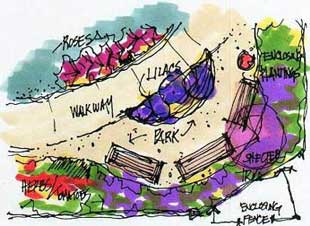
|
||||||||||
|
By
Jann Garitty
|
||||||||||
 Anne
Pera is a Registered Nurse with a certification in holistic nursing from
the American Holistic Nurses’ Association. She has worked with patients
in a variety of clinical settings, and also maintains a private healing-arts
practice in San Rafael, California. Anne has used flower essences personally
and professionally for over 20 years, researching and documenting the effects
of flower essences in clinical practice.
Anne
Pera is a Registered Nurse with a certification in holistic nursing from
the American Holistic Nurses’ Association. She has worked with patients
in a variety of clinical settings, and also maintains a private healing-arts
practice in San Rafael, California. Anne has used flower essences personally
and professionally for over 20 years, researching and documenting the effects
of flower essences in clinical practice.
|
||||||||||
|
One
of Anne’s personal goals is to educate her colleagues in the healthcare
fields about the creative art of “self care,” emphasizing the
gentleness of transition and healing that flower essence therapy can bring
to an increasingly stressful world and workplace.
“Nurses
become nurses because they have an innate desire to relieve the suffering
of others,” she says. “What has happened is that nurses don’t
have enough time to care these days – not for their patients, and
certainly not for themselves.”
|
||||||||||
|
Anne’s
professional nursing specialty has been in home hospice care. She uses a
wide range of healing modalities in her hospice work, using flower essence
therapy as a supportive, transformative bridge to healing for both the critically
ill and the people who care for them. Please read summaries of case notes
on four of Anne’s patients
here
.
In
her private practice, Anne uses Reiki, Lightbody Healing (another hands-on
form of Reiki), Metamorphosis, and massage therapy. With these activational
therapies, deep issues are often brought to conscious awareness. Since
flower essences have been shown to accelerate the release of tension and
the relief of painful physical and emotional symptoms, as well as being
extremely useful in stabilizing the body on many levels, they work well
with these other therapies.
|
||||||||||
|
Bridging
Theapeutic garden designs are intended to be a collaborative effort by all concerned; the designer, institutional/facility staff, and patients. The garden is seen as “medicine” from a holistic nurse’s perspective. A garden is built selectively according to what a particular institution’s needs are. It’s a whole process whereby the staff is drawn into the understanding of the garden’s healing qualities, the medicine of the plants, including flower essences, which can actually be made from it. This concept is modeled after Anthroposophical clinics in Europe.
In April 2002, the pair had the extraordinary opportunity to present to designers of healthcare facilities and others at the annual conference for the Symposium on Healthcare Design in San Francisco. In a workshop entitled “Healing Landscapes: Planning, Designing, Building and Evaluating Outdoor Environments,” Anne used Yarrow Special Formula to illustrate the healing properties of commonly identified plants—Yarrow, Echinacea, and Arnica—and the indications of this particular formulation for environmental healing. Anne’s lecture focused not only on the design of spaces, but also on the assessment of “internal space” – the “inner landscape” required in order to create a truly healing space between practitioner and patient. A guided visualization experience was provided as part of the workshop, providing a practical, personal way for participants to develop a relationship to plants, explore their own “inner landscapes,” and look at nature in a new way.  Beautiful
paintings of flowers used in essences by healing artist Prudence Tiarks
(at left;
Pink Yarrow
) were on display during the workshop, and
the space was enhanced by live, flowering plants. Slides of individual flowers
from the FES slide collection were shown, illustrating the “doctrine
of signatures,” the messages of the plants, and their uses in healing.
Beautiful
paintings of flowers used in essences by healing artist Prudence Tiarks
(at left;
Pink Yarrow
) were on display during the workshop, and
the space was enhanced by live, flowering plants. Slides of individual flowers
from the FES slide collection were shown, illustrating the “doctrine
of signatures,” the messages of the plants, and their uses in healing.
“Our intention was to transform the hotel meeting room into a healing environment,” says Anne. “We misted the air with essences and took time to prepare the room energetically. The enthusiastic response from participants was beyond our expectations – they were really moved by the art, and felt relaxed. It was not a typical experience for this type of conference, and we wanted to demonstrate the need for spaces that are conducive to healing experiences.”
|
||||||||||
|
Anne Pera
is
currently the Director of Health Services, Aegis of San Rafael and a healing
arts practitioner in San Rafael, CA.
Martha Tyson is a landscape architect with Design Consulting in Bailey’s Harbor, WI. |
||||||||||

To install this Web App in your iPhone/iPad press ![]() and then Add to Home Screen.
and then Add to Home Screen.
 When prescribing flower essences in her private practice, Anne has clients
take combinations orally between sessions while applying them directly
to the skin during the actual energy treatments. She uses Seasons of the
Soul Herbal Flower Oils during massage sessions and in hydrotherapy. In
more conventional medical settings that lack knowledge of holistic medicine,
Anne recommends that the best way to integrate the use of essences is
through the use of misted sprays.
When prescribing flower essences in her private practice, Anne has clients
take combinations orally between sessions while applying them directly
to the skin during the actual energy treatments. She uses Seasons of the
Soul Herbal Flower Oils during massage sessions and in hydrotherapy. In
more conventional medical settings that lack knowledge of holistic medicine,
Anne recommends that the best way to integrate the use of essences is
through the use of misted sprays.







